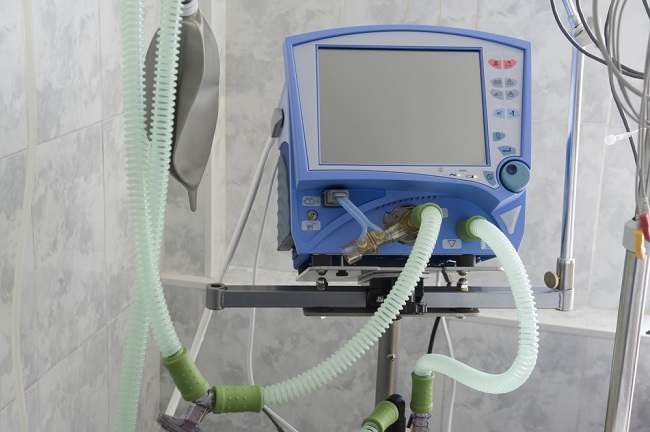Get to know the Ventilator, Benefits, and Weaknesses
Ventilators are machines that function to support or help breathing. Ventilators are often times needed patients who can't breathe themselves , either because an illness or because injury severe . The purpose of using this tool is for patients to get adequate oxygen intake.
Through a ventilator, patients who have difficulty breathing independently can be helped to breathe and get air like breathing normal. The ventilator machine will regulate the process of inhaling and exhaling the patient. The ventilator will pump air for a few seconds to channel oxygen to the patient's lungs, then stop pumping so that the air exits itself from the lungs.

How to P clothes A lat V entilator
Before installing the ventilator in the patient, the doctor will intubate to insert a special hose through the mouth, nose , or a hole made on the front of the patient's neck (tracheostomy). After intubation is complete, the ventilator will then be connected to the hose.
The use of this ventilator machine is quite complicated, so the installation and arrangement should only be done by doctors who have the competence to treat critical patients. This tool is often used in intensive care (ICU), because a condition that requires a ventilator is usually a severe case.
While connected with a ventilator, patients who are still conscious cannot talk or eat by mouth, because there is a hose that goes into the throat. However, patients can still communicate with writing or gestures.
Generally, patients will feel uncomfortable when there is a tube that enters through their mouth or nose. Patients will also sometimes fight the air exhaled by the ventilator, and make the ventilator function less effective. If this is the case, the doctor will provide sedation or pain medication so that the patient feels more comfortable when connected with a ventilator.
Conditions that Make Patients Need a Ventilator
Ventilators are generally used to help the breathing process in patients who cannot breathe on their own. Some conditions or diseases that make patients need a ventilator machine are:
- Severe lung disorders, such as respiratory failure, ARDS (acure respiratory distress syndrome), severe asthma, pneumonia , COPD (chronic obstructive pulmonary disease), and pulmonary swelling (pulmonary edema).
- Nervous system disorders that cause respiratory muscle weakness, coma, or stroke.
- Disorders of the heart, such as heart failure, heart attack, or cardiac arrest.
- Carbon dioxide poisoning.
- Disorders of acid-base balance, namely acidosis and alkalosis.
- Severe injuries, such as extensive burns and severe head injuries.
- Shock.
- Under the influence of general anesthesia, so that the ability to breathe is lost, for example in patients undergoing surgery.
Note that the ventilator machine is not used to treat these conditions, but only as a tool to help patients breathe. In these severe cases, treatment and other treatments are needed in addition to the ventilator to cure or improve the patient's condition.
Risk of Using a Ventilator Tool
During use of the appliance ventilator, there can be several side effects, namely:
- Wounds to the mouth and throat due to intubation.
- Lung infections, usually due to the entry of germs through a breathing hose that is attached in the throat.
- Lung injury and air leak into the cavity outside the lungs ( pneumothorax ).
- Loss of ability to cough and swallow, so phlegm or mucus in the airways can accumulate and interfere with the entry of air. The doctor or nurse will do regular suctioning to remove this phlegm or mucus.
- Oxygen poisoning.
In addition, the patient is connected with a ventilator and must lie down for long risk of developing decubitus wounds and impaired blood flow due to thromboembolism.
Although ventilator use has an important role in patient care, the risk is not small. The use of ventilator devices also generally requires large costs. The longer the patient is treated using a ventilator, the more costs must be incurred.
Therefore, patients and their families need to understand the advantages and risks of using this machine. If you are still hesitant about installing a ventilator, it is recommended to consult with the treating doctor to get a more detailed explanation.
Decision to Release the Ventilator Tool
Duration of patient time having to be connected with a ventilator cannot be estimated. How long does the patient need to use a ventilator and when the patient can be released from this device will be determined based on the development of the patient's condition and clinical evaluation by the doctor.
Some patients may only be connected with a ventilator for several days, time for months. Every day the doctor will evaluate the condition of the patient, is there an improvement and is able to breathe on his own well without the help of a ventilator.
During treatment, patients who are attached to a ventilator will receive close monitoring and regular checks. After showing improvements, both from the results of physical examinations and investigations, such as blood tests, urine, or X-ray photos, the ventilator may be removed.
The use of a ventilator is very necessary for the survival of patients who cannot breathe own. If your family needs to be admitted to the ICU and needs a ventilator, you should discuss it with the treating doctor to get clearer information about the benefits and risks of using this breathing machine.
Written by:
dr. Michael Kevin Robby Setyana
Label : Health
Comments
Post a Comment